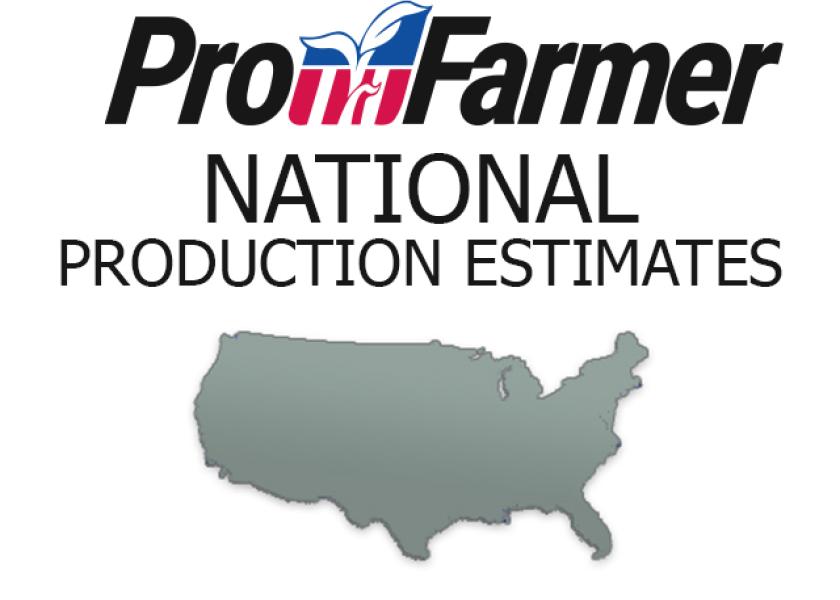Pro Farmer Releases National Corn and Soybean Crop Estimates

Pro Farmer national corn and soybean crop estimates:
- Corn: 15.116 billion bu.; Average yield of 177 bu. per acre
- Corn +/- 1% = 15.267 billion bu. to 14.965 billion bu.; 178.8 bu. to 175.2 per acre
- Soybeans: 4.436 billion bu.; Average yield of 51.2 bu. per acre
- Soybeans +/- 2% = 4.525 billion bu. to 4.347 billion bu.; 52.2 bu. to 50.2 bu. per acre
Note: The national estimates above reflect Pro Farmer’s view on production and yields. They take into account data gathered during Crop Tour and other factors like crop maturity, acreage adjustments, historical differences in Tour data versus USDA’s final yields, areas outside those sampled on Tour, etc. That’s why the state yield numbers below differ from the Crop Tour figures. For corn, we raised harvested area by 910,000 acres (based on FSA data) versus USDA’s June estimate. USDA in August estimated the corn crop at 14.750 billion bu. on a national average yield of 174.6 bu. per acre. It estimated the bean crop at 4.339 billion bu. on a 50.0 bu. per acre yield.
Following are Pro Farmer’s state by state corn yield estimates:
Iowa: 198 bu. per acre. We saw a lot of good corn, a fair amount of bad corn and plenty in between. That’s unusual for Iowa and it will hold back the final yield.
Illinois: 212 bu. per acre. Will there be enough pockets of excellence to offset nicks from dryness and wind, enabling the crop to hit USDA’s lofty 214 bu. per acre peg? We doubt it, but it could come close. Late-season rains are needed to maintain the yield potential we measured.
Nebraska: 190 bu. per acre. Irrigated corn is going to pull up yields, offsetting some dryland losses. We measured a more mature crop that needs some rain to hold onto the yield potential it has. If rain doesn’t fall on dryland corn soon, it will go backward.
Minnesota: 170 bu. per acre. Minnesota corn has the appearance of a dry-season crop, but we were surprised just how well it held on. The crop built yield early and was spoon-fed rain in the nick of time. Central areas of the state where drought is more severe will hold down yields, but our numbers suggest USDA cut too deep with its Aug. 1 estimate.
Indiana: 200 bu. per acre. Who would’ve thought Indiana would join the 200 bu. club before Nebraska? Consistency was unbelievable. Scouts pulled just one sub-100 bu. per acre sample there. But again, rain is needed to finish strong.
Ohio: 190 bu. per acre. This is often a hit or miss state, and this year there weren’t many misses. The yield factory is there for a record crop.
South Dakota: 140 bu. per acre. Heat and dryness are going to keep the crop subpar, and scouts measured yield more so than yield potential, which is rare for the state. Rains are needed and the risk is to the downside.
Following are Pro Farmer’s state-by-state soybean yield estimates:
Iowa: 57 bu. per acre. We were underwhelmed by Iowa’s bean crop. Soil moisture was up 10.5% from last year’s dry crop but down 31% from average. If the state doesn’t get rains, yields could fall even further from USDA’s Aug. 1 58-bu.-per-acre peg.
Illinois: 66 bu. per acre. The crop has a better chance than corn of hitting USDA’s forecast, in our opinion. Plants were loaded with pods and rain fell during Tour. But more will likely be needed to maximize yield potential.
Nebraska: 58 bu. per acre. We sampled a pretty average Nebraska soybean crop. That said, we’ve learned never to underestimate the ability of the Nebraska bean crop to build yield late in the season. Disease and insect pressure was limited, but the crop needs rain.
Minnesota: 46 bu. per acre. Scouts found fewer pods and less moisture than last year. And last year’s crop didn’t finish well.
Indiana: 62 bu. per acre. USDA is calling for a record crop, but getting there would require ideal conditions until harvest. The verdict is still out on whether the state will have the moisture to finish and fill pods that are there.
Ohio: 60 bu. per acre. A big crop is in the works, especially if it catches a few more rains, but the crop may have a bit too much variability to hit maximum yields. Rains fell as scouts sampled fields, which will help. But a hot, dry stretch could erode yield potential in a hurry.
South Dakota: 41 bu. per acre. Spotty rains resulted in pod counts all over the board, resulting in a fairly ordinary South Dakota bean crop. If expected rains don’t develop soon, the crop will set back.
*For more details on Pro Farmer’s crop estimates and crop tour finding, be sure to read this week’s newsletter.
Read full coverage of the 2021 Pro Farmer Midwest Crop Tour






